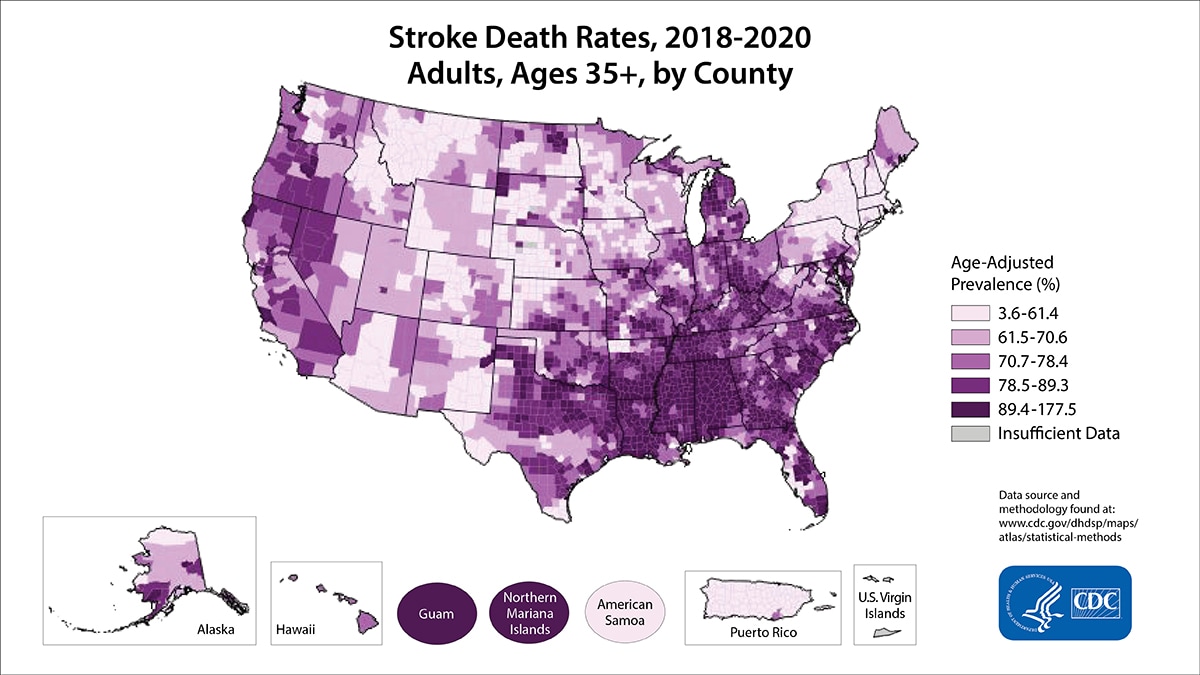What to know
- Stroke risk increases with age, but strokes can—and do—occur at any age.
- Early action is important for stroke.
- Stroke statistics vary by race and ethnicity.

Fast facts
- In the United States in 2022, 1 in 6 deaths (17.5%) from cardiovascular disease was due to stroke.1
- The death rate for stroke decreased from 41.1 per 100,000 in 2021 to 39.5 per 100,000 in 2022.1
- Every 40 seconds, someone in the United States has a stroke.2 Every 3 minutes and 11 seconds, someone dies of stroke in this country.1
- Every year, more than 795,000 people in the United States have a stroke.2
- About 610,000 of these are first or new strokes.2
- About 185,000 strokes—nearly 1 in 4—are in people who have had a previous stroke.2
- About 87% of all strokes are ischemic strokes, in which blood flow to the brain is blocked.2
- Stroke-related costs in the United States came to nearly $56.2 billion between 2019 and 2020. Costs include the cost of health care services, medicines to treat stroke, and missed days of work.3
- Stroke is a leading cause of serious long-term disability.2
- Stroke reduces mobility in more than half of stroke survivors age 65 and older.2

Stroke statistics by race and ethnicity
- Stroke is a leading cause of death for Americans.
- The risk of having a stroke varies with race and ethnicity.
- Risk of having a first stroke is nearly twice as high for non-Hispanic Black adults as for White adults.2
- Non-Hispanic Black adults and Pacific Islander adults have the highest rates of death from stroke.1
Stroke risk varies by age
- Stroke risk increases with age, but strokes can—and do—occur at any age.
- In 2014, 38% of people hospitalized for stroke were less than 65 years old.4
Early action is important for stroke
Know the warning signs and symptoms of stroke so that you can act fast if you or someone you know might be having a stroke. The chances of survival are greater when emergency treatment begins quickly.
- In one survey, 93% of respondents recognized sudden numbness on one side as a symptom of stroke.
- Only 38% were aware of all major symptoms and knew to call 9-1-1 when someone was having a stroke.5
- Patients who arrive at the emergency room within 3 hours of their first symptoms often have less disability 3 months after a stroke than those who receive delayed care.5
Populations
Americans at risk for stroke
High blood pressure, high cholesterol, smoking, obesity, and diabetes are leading causes of stroke. One in three US adults has at least one of these conditions or risk factors.2
Learn how to take steps to prevent stroke.
What CDC is doing
CDC and its partners are leading national initiatives and programs to reduce rates of death and disability caused by stroke and to help people live longer, healthier lives.
CDC's Division for Heart Disease and Stroke Prevention (DHDSP) provides resources to all 50 states to address heart disease and stroke, as well as helping lead or support the following:
- The WISEWOMAN program screens women aged 35 to 64 who with low incomes and little or no insurance for chronic disease risk factors and refers them to lifestyle programs in an effort to prevent heart disease and strokes.
- The Paul Coverdell National Acute Stroke Program funds states to measure, track, and improve the quality of care for stroke patients. The program works to reduce death and disability from stroke.
- The Million Hearts® initiative, which is co-led by CDC and the Centers for Medicare & Medicaid Services, works with other federal agencies and private-sector partners to raise awareness about heart disease and stroke and prevent heart attacks and strokes.
Resources
CDC
- Signs and Symptoms of Stroke
- Facts About Hypertension
- High Cholesterol Facts
- Smoking & Tobacco Use
- Diabetes Fast Facts
- Adult Obesity Facts
Other organizations
- National Institute of Neurological Disorders and Stroke (NINDS): Stroke Information Page
- NINDS Know Stroke Campaign
- National Institutes of Health: Mind Your Risks®
- MedlinePlus: Stroke
- Brain Attack Coalition
- National Center for Health Statistics. Multiple Cause of Death 2018–2022 on CDC WONDER Database. Accessed May 3, 2024. https://wonder.cdc.gov/mcd.html
- Tsao CW, Aday AW, Almarzooq ZI, et al. Heart disease and stroke statistics—2023 update: a report from the American Heart Association. Circulation. 2023;147:e93–e621.
- Martin SS, Aday AW, Almarzooq ZI, et al.; American Heart Association Council on Epidemiology and Prevention Statistics Committee; Stroke Statistics Subcommittee. 2024 heart disease and stroke statistics: a report of US and global data from the American Heart Association. Circulation 2024;149:e347–913.
- Jackson G, Chari K. National hospital care survey demonstration projects: stroke inpatient hospitalizations. Natl Health Stat Report. 2019 Nov;(132):1–11.
- Fang J, Keenan NL, Ayala C, Dai S, Merritt R, Denny CH. Awareness of stroke warning symptoms—13 states and the District of Columbia, 2005. MMWR Morb Mortal Wkly Rep. 2008;57(18):481–485.
